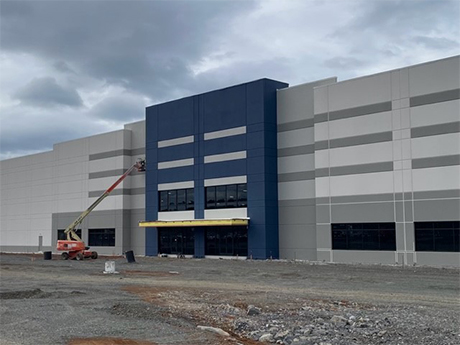While there has been a discernible dip in the volume of industrial leasing activity occurring in the greater Baltimore metropolitan area this past year, optimism remains high among owners and investors of this asset class given the diminishing volume of new product under construction, the still low 7.4 percent overall vacancy rate, record high — yet stabilizing — average asking rents of $10.54 per square foot net and the fact that 10 million people are not likely to soon move away from the Baltimore-Washington, D.C. corridor, the fourth-largest combined metropolitan statistical area in the country.

Oh yes, spirits remain high following the Baltimore Orioles’ underdog ride to the top of the American East standings this summer. Never underestimate the power of a professional sports franchise to energize an entire region.
The metro Baltimore industrial market consists of more than 3,600 buildings, totaling more than 266 million square feet of space that includes flex and industrial Class A, B and C buildings. Year-to-date, the market has yielded negative absorption of approximately 1 million square feet of space, including nearly 300,000 square feet this past quarter.
The bad news of GXO Logistics shuttering a 571,000-square-foot distribution center in Harford County and laying off more than 175 workers is balanced by Con Air’s decision to lease more than 2.1 million square feet of space and hire more than 700 employees in the Hagerstown area. The Con Air move represents the largest industrial lease this year.
Since June, over 700,000 square feet of new industrial leases have been signed in the Hagerstown market. Construction is nearly complete on MCB Real Estate’s two-building, 1.5 million-square-foot Currwood Logistics Center, and tenant activity has been strong in the 1 million-square-foot regional occupier category.
Fifteen new buildings totaling 1.7 million square feet of space were delivered to the market last quarter, a considerably slower pace that can be attributed to increased construction costs, perceived softness in the market, the high barrier to entry given the lack of properly zoned land, rising interest rates, the rise of the NIMBYs and rising construction costs, which have placed several ready-to-go projects on hold.
A high-profile example of NIMBYism to squelch a possible 5.2 million-square-foot development is playing out in Harford County, which led to the placement of a short-term moratorium on construction by local officials. Another battle is emerging in Baltimore County to slam the brakes on a new 450-acre, 3 million-square=foot industrial project that was previously approved. Residents are becoming increasingly empowered and, in some cases, are finding sympathetic elected officials to support their cause.
While conditions vary market to market, it appears leasing activity across the board may be resorting to pre-pandemic levels. The region remains attractive to e-commerce companies interested in serving the robust location that can reach one-third of the U.S. population within a one-day truck drive, as well as having access to a highly trained and fertile labor force that ranks No. 5 in the highest workforce of logistics nationally.
Additionally, the State of Maryland continues to invest in the Port of Baltimore. In 2022, the port added four more new Neo-Panamax cranes to move containers and it remains the No. 1 roll-on roll-off cargo port in the country (“RoRo” cargo includes vehicles, trucks, and farm equipment).
Furthering the narrative of slowing leasing velocity is evidenced by the 1.9 million square feet of space leased last quarter, nearly a 40 percent decrease of space leased as compared with the 3.1 million square foot total in third-quarter 2022. On the bright side, recent highlights include Electrolux USA’s decision to extend its nearly 700,000-square-foot lease in Harford County and Floor & Décor’s announcement last quarter to add a second distribution building at Trade Point Atlantic, adding 165 new full-time jobs.
Large industrial investment sales maintain a slight heartbeat led by Prologis acquiring four buildings totaling more than 500,000 square feet of space near BWI Airport in Anne Arundel County as part a larger 74-building nationwide acquisition. Also, near BWI Airport, Longpoint Realty Partners picked up a seven-building portfolio from Amazon for $116 million, totaling nearly 650,000 square feet.
A number of smaller sales under $10 million were also recorded as high interest rates have not kept owner-occupiers from chasing an increasingly diminished supply in an effort to fix occupancy costs to counter the excessive rise in rental rates. The surging industrial outdoor storage (IOS) asset class has also remained active as private equity investors search for income and yield continuing the roll-up of this asset class.
The consensus, following a three-year frenetic pace that has been unprecedented in the careers of most industrial real estate brokerage professionals driven by the pandemic accelerating e-commerce, where lease negotiations became a “take-it-or-leave-it” proposition from landlords is now showing signs shifting ever slightly toward the tenant’s favor. Owners have become a bit more aggressive in lease negotiations, with an increased amount of rent abatement and the offering of additional tenant improvement dollars.
While the Baltimore industrial market vacancy level may be slowly creeping higher, just like local sports fans that now have long-term optimism of their beloved baseball team following this year’s breakthrough season, spirits still remain high in the industrial sector in the face of softening demand.
— By Daniel Hudak, SIOR, Senior Vice President, Principal, MacKenzie Commercial Real Estate Services. This article was originally published in the November 2023 issue of Southeast Real Estate Business.


